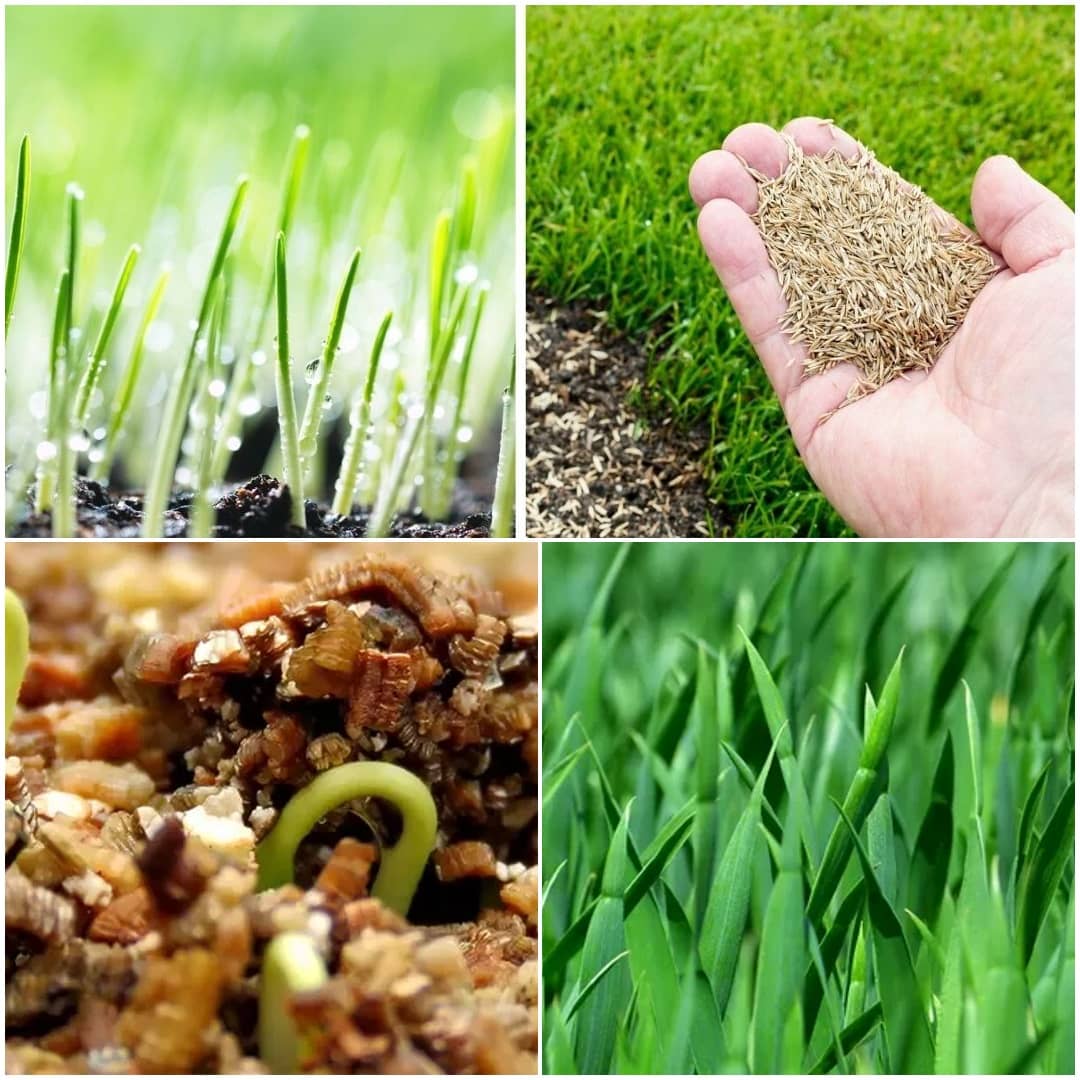Establishing a lush, green lawn begins with knowing how to plant grass seed properly. Whether you’re starting a new lawn from scratch or reseeding bare patches, following the right steps will ensure success. In this guide, we’ll walk you through each stage of the process to help you grow healthy, vibrant grass that thrives for years to come.
How to Plant Grass Seed
Remove Weeds and Prepare the Soil
Before you begin planting grass, it’s essential to remove existing weeds and prepare the soil. Weeds compete with grass for nutrients, water, and light, so clearing them out ensures a strong start for your new lawn.
- Remove Existing Grass and Weeds: Use a shovel to dig out grass or weeds, removing as many roots as possible. If you’re working on a large area, consider renting a seed cutter to save time and effort.
- Clear Debris: Once the weeds are removed, rake away any debris, such as stones or large clumps of soil, to create a clean, smooth surface for planting.
Enrich the Soil and Smooth the Surface
Healthy soil is the foundation of any lawn. Enriching the soil and preparing a smooth surface is crucial for optimal grass growth.
- Add Compost: Spread a 2-inch layer of well-decomposed compost over the planting area. Compost adds nutrients to the soil and improves drainage, which helps the grass grow strong and healthy.
- Till the Soil: Till the compost into the soil to a depth of about 4 inches. This step helps mix the compost evenly and loosens the soil for better root penetration.
- Rake the Area Smooth: Use a garden rake to create a smooth, level surface. Remove rocks, clods of soil, and any remaining debris to ensure the soil is loose and ready for planting.
Planting the Grass Seed
With the soil prepared, it’s time to plant the grass seed. Whether you’re planting a small patch or an entire lawn, the method is the same.
- Scatter Seed by Hand or Use a Spreader: For smaller areas, you can scatter the seed by hand. For larger areas, use a drop spreader to evenly distribute the seed. Make sure to do this on a calm day to avoid the wind scattering the seeds unevenly.
- Seeding Rate: Follow the seeding rate provided on the seed bag. A common approach is to spread half the seed in one direction, then spread the remaining half at a right angle to ensure even coverage.
Protect the Grass Seed
After the seed is sown, it’s important to protect it and give it the best chance to grow.
- Cover with Soil: Lightly rake the area to cover the seeds with a thin layer of soil. This step helps anchor the seeds and protects them from being blown or washed away.
- Add a Layer of Straw: Spread a thin layer of weed-free straw over the seeded area. This helps retain moisture, shields the seed from birds, and prevents erosion.
Watering the Seed for Successful Germination
Water is one of the most critical factors in successful grass seed germination. Proper watering will ensure that your seeds grow into a thick, healthy lawn.
- Light Watering: Use a sprinkler to lightly water the seedbed. Keep the soil moist but not saturated, as too much water can cause the seeds to sink too deeply into the soil.
- Watering Schedule: Water the seedbed a couple of times a day until seedlings begin to emerge, which typically happens within 2 to 4 weeks. After the grass reaches 2 inches in height, reduce watering to once a day.
Mow New Grass and Control Weeds
Once your grass has started to grow, proper maintenance will keep it looking lush and healthy.
- Mowing the Grass: Begin mowing when the grass reaches about 4 inches tall, and aim to maintain a height of around 3 inches. Regular mowing encourages stronger root growth and a denser lawn.
- Weed Prevention: After about two months of mowing, it’s safe to apply a weed prevention product to control unwanted invaders like crabgrass. Always read the product label for proper application instructions.
How Long does it Take Grass Seed to Grow
Grass seed germination can vary based on several factors, including species, weather, and soil conditions.
- Germination Time: Grass seed typically germinates within 5 to 10 days, though this can vary slightly depending on environmental conditions.
- Growth Rate: Once germinated, grass will grow at a rate of about 2/3 cm per week under ideal conditions.
Factors That Affect Germination
Several factors can influence how quickly your grass seed germinates:
- Time of Year: Grass seed should be planted in mid to late spring or early autumn. Avoid planting during winter, as cold temperatures will delay or prevent germination.
- Soil Temperature: The soil should be at least 8°C for grass seed to germinate properly.
- Climate: Grass seed in warmer climates or southern areas may germinate faster than in colder northern regions.
How to Reseed Lawn
Sometimes, your lawn might need reseeding to fill in bare patches or revitalize tired areas.
- Turn Over the Turf: Use a garden fork or cultivator to expose the soil by turning over the turf. This helps create a good base for the grass seed and suppresses missed weeds.
- Add Compost and Level the Area: Apply compost liberally and rake the area level, ensuring the soil is smooth and free of debris like stones or rocks.
- Scatter Grass Seed: Follow the supplier’s recommended rate for sowing. If in doubt, sowing a bit more is always better than sowing too little.
- Compact the Seed: Lightly tread over the reseeded area to compact the seed into the soil, ensuring good seed-to-soil contact.
- Water Thoroughly: Water the seeds to ensure they have enough moisture to germinate. If rain is forecast, you can let nature handle the job.
How Fast does Grass Grow per Day
Under ideal conditions, grass can grow up to 1/5 of an inch per day. However, the actual growth rate depends on several factors, including grass species, climate, and soil quality.
- Weekly Growth Rate: In well-maintained conditions, grass can grow about 1 inch per week.
How long does Grass Seed last
If stored properly, grass seed can last for up to 2 to 3 years before its germination rate begins to decline.
- Germination Decline: After the first few years of storage, the germination rate decreases by about 10% per year. It’s best to use grass seed within two years for optimal results.
- Storage Tips: Store grass seed in cool, dry conditions, such as a garage or shed, and keep it off the ground to avoid moisture exposure.
Will grass seed germinate on top of soil
Planting grass seed on top of the soil is a highly effective method known as surface sowing. This technique is particularly well-suited for grass seeds, as they lack the strength to push through a top layer of soil. When buried too deeply, grass seeds often struggle to sprout, which can hinder or completely stop their growth. By keeping the seeds on the soil surface, they can access the necessary sunlight and air, allowing them to germinate and thrive more easily.
The Benefits of Surface Sowing for Grass Seeds
Surface sowing is an ideal approach for planting grass because grass seeds have shallow roots that require direct contact with air and moisture. The absence of a thick soil cover allows them to germinate without any obstruction. When applied correctly, surface sowing ensures a dense, healthy lawn with even coverage.
Steps for Planting Grass Seed on Top of Soil
To get the best results when planting grass seed on top of the soil, follow these simple steps:
1. Prepare the Soil
Before sowing the grass seed, it’s essential to prepare the soil properly. Start by loosening the soil with a rake, ensuring that the surface is fertile and loose. A loose, well-aerated soil provides the ideal conditions for the seeds to settle and root. Remove any rocks, debris, or weeds to create a smooth, even surface for planting.
2. Spread the Seeds Evenly
Once the soil is prepared, spread the grass seeds evenly across the surface. For small areas, you can scatter the seeds by hand, but for larger areas, using a broadcast spreader or rake is recommended. Make sure the seeds are spread uniformly to avoid patchy growth. This will give the lawn a consistent and healthy appearance as the seeds germinate.
3. Protect the Seeds with a Light Layer of Hay
After spreading the seeds, cover them with a light layer of weed-free hay. This layer of hay acts as a protective barrier, preventing the seeds from being blown away by the wind or eaten by birds. It also helps retain moisture, which is crucial for seed germination. Avoid using straw, as it often contains weed seeds that can sprout and compete with your grass.
4. Water the Seeds Thoroughly
Proper watering is essential for grass seed germination. Water the area thoroughly immediately after planting, ensuring the soil is moist but not oversaturated. The goal is to keep the soil consistently moist while the seeds are germinating. This process usually takes 2-4 weeks, during which the soil should never dry out completely. Watering at least twice daily is recommended to maintain optimal moisture levels for germination.
Key Tips for Successful Grass Seed Germination
- Water frequently: Water the area at least twice a day to keep the soil moist throughout the germination process.
- Use weed-free hay: Avoid using straw, as it may contain weed seeds that could sprout alongside your grass.
- Choose the right grass seed: Select a grass seed variety that is well-suited to your local climate and soil conditions to ensure a thriving lawn.
Why Grass Seed Germinates Best on Top of Soil
Unlike other plants that can tolerate being buried, grass seeds need direct exposure to light and air to germinate. When planted too deep, they may struggle to push through the soil, leading to poor growth or complete failure. Surface sowing ensures that the seeds are in the best possible position to absorb the nutrients they need while allowing them to establish roots efficiently.
FAQs:
What months are best to put grass seed down?
The best months to plant grass seed are early spring and early autumn. These times provide ideal growing conditions because the soil is warm enough for germination, but the weather is cool enough to prevent excessive drying. In spring, you can plant grass seed from March to May, while autumn planting is usually best from September to October. These periods offer the right balance of moisture, temperature, and sunlight for grass seed to thrive.
How long does it take to pre-germinate grass seed?
Pre-germinating grass seed typically takes about 3 to 5 days. To pre-germinate the seeds, soak them in water for about 24 hours, then drain and place them in a warm, moist environment. Stir the seeds daily to allow even germination, and after a few days, you’ll notice small roots beginning to sprout. At this stage, the seeds are ready to be sown into the soil for faster growth and establishment.


